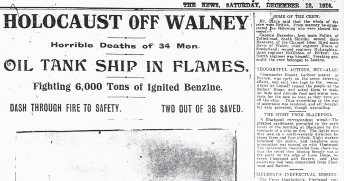In the Channel Islands, much of this work is carried on by the Channel Islands Great War Study Group.
Recently, we have been informed by CIGWSG member Barrie Bertram of the hitherto unrecorded death of John Le Masurier, second mate on the SS Vedra, who was Jersey’s first Merchant Navy casualty in the Great War. His ship blew up and sunk when laden with submarine fuel. On 8 December it was the 95th anniversary of his death. The ship’s loss occurred south of Walney Island off Morecambe Bay.
There was a gale blowing and a very heavy sea was running on the evening of 7 December, as the Vedra was approaching Barrow-in-Furness, having left Sabine in Texas and crossed the Atlantic, with some 6,000 tons of highly volatile benzine as its cargo.
According to The Times, the ship was built at Sunderland in 1893, was a vessel of 4,057 tons, and was owned by Associated Oil Carriers Ltd. On board was a crew of 36 men. As she approached Barrow she anchored. Signals to request a pilot had been made, but before one could board, the ship was driven ashore at the southern end of Walney Island.
Attempts were immediately made to refloat her but these were unsuccessful, with two hawsers that had reached her each parting, and two tugs that had been despatched to assist failing to move her, while lifeboats had also been called. The Vedra’s engines had been disabled in the grounding and one account suggests that the pounding seas had caused the double tank seams to split, causing benzine to spill. The crew had also commenced pumping the oil out, to lighten the ship, while it appears that an offer for the crew to be removed by lifeboat was declined.
According to the account of survivor Fourth Engineer James Dixon, between 3 and 3.30 am there was an explosion and the SS Vedra was engulfed in flames throughout. There are various accounts to suggest the cause. One eyewitness from one of the boats standing off to render assistance indicates that the donkey engine had been lit and, with the amount of benzine around, this had rapidly caught. The main engine fires had by this time, of course, been drawn.
Whatever the cause, most of the crew were seen to be screaming and running around in panic, while others leapt overboard to die in the cold waters. Of the 36 crew members, only two would survive the conflagration. James Dixon, as has already been mentioned above, and Second Engineer Frederick McLaughlin. Both were taken to hospital, where McLaughlin would die from his injuries. The fire and smoke was reported as being visible at Blackpool. Among those lost was John Le Masurier.
As best as can be understood, benzine is one of a range of petroleum products that also includes naphtha and kerosene and in effect was a fuel, probably intended for use in submarines.
Mr Bertram said: ‘Sadly, the crew are not commemorated by the Commonwealth War Graves Commission, as it was assumed that the loss was not regarded as attributable to a war risk. Was that an appropriate position to adopt? Clearly UK territorial waters were regarded as part of the war zone, while German U-boats were active from the earliest days of the war, as evidenced by the sinking of HMS Aboukir, Cressy and Hogue.
‘Five weeks before the loss of the Vedra, Great Yarmouth had been shelled and the German Navy would pay a further call on Scarborough, Whitby and Hartlepool on the 16th December.
‘Later in the war, the Otranto would collide with the Kashmir while bringing US troops over. In a number of respects, this mishap has many parallels with the Vedra in terms of carrying war material and the crew are commemorated, not least Charles Hacking from Jersey. But perhaps in the case of the Otranto, having been impressed as an Armed Merchant Cruiser, it was regarded in a different light.’
Mr Bertram is currently investigating what happened to the bodies of the deceased crewmen, whether they received a proper burial or whether, like so many naval deaths, no memorial and no flowers mark their resting place.






